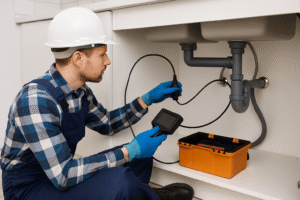Mold goes deeper than a surface stain. It grows deep inside your home. It spreads through drywall, wood, and carpet. You see a small patch, but it keeps growing behind the surface.Mold also causes real health problems. It releases spores into the air. You breathe those in. Your body reacts. You may start coughing. Your eyes may burn. Your nose stays stuffy. People with asthma or allergies feel it worse. Children and older adult face even higher risk.
The damage does not stop there. Mold weakens walls. It eats away at wood. It ruins paint and insulation. It spreads under floors and behind cabinets. If left alone, it takes over entire rooms.Many people overlook the first signs. They think it’s just dirt or a stain. They clean the surface and move on. Then the smell shows up. Then the wall bubbles. Then health symptoms appear. At that point, the problem has grown.
You don’t need to wait that long. You don’t need to risk your health or your home. You can take control early. You can fix small problem before they become disaster. You only need to know what to check and how to act.Your home should feel safe. Mold take that away. It bring risk and discomfort. You do not have to live with that. You can stop it.
What Does Mold Look Like?
Mold appear in many color. You may see black green or white patches. These patches look fuzzy slimy or flat. They grow in cluster or spread across large area.You will often find them on wall ceiling or tile grout. Bathroom and kitchen are usual problem zones. These room stay damp. Moisture linger after showers or cooking. That give mold a place to grow.
Also mold hides in places you do not see every day. It can spread behind furniture. It can grow under rugs or carpets. It may hide inside closets or behind curtains. These areas collect dust and trap moisture.Corners often show early signs. Window sills and frames also attract mold. Condensation gathers there. That damp air fuels mold quickly.
You might notice dark rings or shadowy streaks on the paint. These may look harmless. They aren’t. Mold rarely stays on the surface. It digs in and spreads fast.If something looks off, don’t ignore it. If you see spots that return after cleaning, it’s likely mold. Check the area again and move fast. Mold never leaves on it own
Can You Smell Mold?
A musty smell means trouble. It often shows up before you see any mold. That smell is strong. It fills the room. It clings to fabrics and sticks to the air.Mold releases spores as it grows. Those spores create the odor. You may notice it in closed spaces. Basement attics and laundry room are common spot. The smell tells you something is growing out of sight.
Also, the smell may move through vents. It can travel between rooms. If one area smells off, follow the scent. Mold could be behind a wall or under flooring.
If the smell stays after you clean, that’s a clue. You likely cleaned the surface, not the source. Mold often hides deep inside materials. You may need to look behind drywall. You may need to pull up carpet or inspect inside cabinets.Don’t ignore that musty odor. It will not fade on its own. It means mold is still active. The longer it stays, the worse the damage gets.Your nose can find mold before your eyes do. Trust it. If the air smell damp stale or earthy take action.
How Moisture Lead to Mold
Moisture feeds mold. Without water, mold can’t survive. Even small amounts of moisture create the right conditions.Leaks cause most mold problems. Pipes crack. Roofs drip. Water sneaks in through windows. These leaks may stay hidden for weeks. Mold starts to grow long before you see it.You might notice stains on ceilings. You may see paint bubble or peel. These signs mean water has been there. Mold often follows close behind.
Bathrooms are trouble spots. Hot showers fill the room with steam. Water sits on tile, walls, and mirrors. If the air stays damp, mold moves in.Basements trap moisture too. Poor ventilation and cool air help mold grow. Crawl spaces under homes hold damp soil and standing water. Mold spreads easily in these places.
Also, appliances can cause leaks. Washing machines overflow. Dishwashers leak under cabinets. Water heaters drip in closets or garages.You must fix leaks fast. Even a slow drip creates a serious mold problem. Dry the area fully. Mold will return if moisture stay.Moisture invites mold every time. Controlling water is the first step to keeping mold away.
Why Humidity Matter
Humidity give mold exactly what it need. When air hold too much moisture mold begin to grow. You can not always see it but you will feel it. The room feel damp. The air feel heavy.Indoor humidity above 60% is a problem. That level create the perfect space for mold. Bathroom kitchen and laundry rooms often pass that limit.
You can check humidity with a small monitor. These are cheap and easy to use. If the number is high, act fast. Mold won’t wait.A dehumidifier helps pull moisture out of the air. It keeps rooms dry and stops mold from growing. Use it in damp areas. Let it run after you shower or wash clothes.
Good airflow matters too. Open windows on dry days. Let fresh air move through the house. Air circulation help moisture escape.Turn on exhaust fan after cooking or bathing. Let them run for at least 20 minutes. Close doors to trap steam, then vent it outside.Mold cannot grow without moisture. When the air stays dry, mold dies. Control humidity, and you control mold.
What To Do When You Find Mold
Act fast when you see mold. Don’t wait. Mold spreads quickly. It won’t stop on its own.Start by checking how large the patch is. Small spots are easier to handle. You can clean them yourself. Use soap and warm water. Scrub the surface until the mold disappear. Dry the area fully once you finish.Always wear gloves. Use a mask if you can. Keep windows open while you clean. Let fresh air move through the space.
Check the surrounding area. Mold often hides near what you can see. Look behind furniture or under rugs. Examine corners and baseboards. Make sure the patch is truly small.
If the mold cover more than a few feet call a professional. Large infestation often spread deeper than you think. Mold may grow inside wall behind cabinet or under floor.Experts use special tool to find hidden mold. They can remove it without spreading spore into the air. They also treat the area to stop mold from coming back.Don’t try to clean big patches yourself. You could make the problem worse. It’s safer to get help when the mold looks severe.
Why You Must Act Fast
Mold does not stay in one place. It spreads fast. It moves through walls, ceilings, and vents. Once it reaches new areas, it keeps growing.Mold weakens everything it touches. It eats away at wood. It ruins paint. It breaks down drywall. These materials lose strength. They start to rot or crumble.Repairs get expensive if you wait. What starts as a small patch can lead to full wall replacements. Floors may need to be ripped out. Cabinets may need to be removed. Waiting turns a small job into a costly project.
Also, mold affects your health. It releases spores into the air. You breathe them in every day. You may feel tired congested or short of breath. Your skin may itch. Your eyes may burn.
People with asthma feel worse. Children babies and older adult suffer more. Even healthy people develop problems over time. Mold exposure never helps. It only harms.You must act as soon as you see or smell mold. Delaying give mold time to spread. The longer you wait the more damage it cause. Quick action protect both your home and your health.
How To Prevent Mold
You don’t need to wait for mold to show up. You can stop it before it starts. Regular checks keep your home safe.Look around your home often. Pay close attention to damp area. Bathroom kitchen basement and laundry rooms need the most care. These place trap moisture fast.Fix leak right away. Do not put it off. Even a small drip can lead to mold in a few days. Dry any wet surface as soon as you see it. Mold needs moisture. Remove the water and you stop the growth.
Also, turn on exhaust fans after showers or baths. Let them run long enough to dry the room. Steam from hot water cling to walls and ceiling. It create the perfect place for mold to grow.
Open windows on dry days. Let fresh air move through your home. Airflow keeps humidity low. Mold struggle in dry moving air.Use a dehumidifier in room that stay damp. Keep humidity between 30 and 50 percent. That range help stop mold before it start.Prevention is simple but powerful. Regular care save you from damage stress and health issues.
Stop Mold Before It Gets Worse
Mold doesn’t wait. It grows fast. It spread into place you can not see. It hide behind wall under floor and inside vents. You won’t always spot it right away. But you can still catch it early.Use your eyes and your nose. Look for stain dark spot or peeling paint. Smell for musty odor. These sign mean mold is active.
Fix water problems the moment they appear. Stop leaks. Dry wet spots. Lower humidity. These steps make a big difference.Early action protects your home. It also protects your health. Mold brings damage, stress, and costly repairs. But it only wins if you ignore it.
You do not have to fight it alone. Call a mold expert if the problem feel too big. Getting help early saves time and money.Take control before mold takes over. Small step today keep your home clean dry and safe.
Conclusion
Mold is deeper than a surface or a scent. It spreads fast. It hides where you don’t look. It harms your health. It weakens your home.Many people miss the early signs. They ignore a small patch. They brush off a musty odor. Then mold spreads behind the walls. Then the air feels heavy. Then repairs cost thousands.You don’t need to let it get that far. You can take control right now. You can check your home today. You can fix small leaks. You can dry wet spots. You can open windows. You can turn on fans. Each small action keeps mold away.
Stay alert. Watch the corners, ceilings, and floors. Check under carpets. Look behind furniture. These spots collect moisture and hide mold.Also, listen to your body. Mold affects your breathing. It irritates your skin and eyes. If you feel worse at home, mold could be the reason.
Take action early. Don’t wait for mold to take over. Don’t wait for damage or health problems. Clean small spots right away. Call professionals for big problems.You can stop mold before it spreads. You can protect your family and your home. All it takes is attention, care, and fast action.Mold does not belong in your home. Keep it out. Keep your space dry clean and safe.




